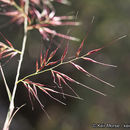Comprehensive Description
provided by North American Flora
Muhlenbergia pauciflora Buckl. Proc. Acad. Phila. 1862: 91 1863.
Muhlenbergia sylvalka var. Pringlei Scrihn. Bull. Torrey Club 9: 89. 1S82. (Type from Santa
Rita Mountains, New Mexico, Pringle 480.) Muhlenbergia neo-mejcicana Vasey, Bot. Gaz. 11: 337. 1886. (Type from New Mexico.) Muhlenbergia Pringlei Scribn. in Vasey, Contr. U. S. Nat. Herb. 3: 71. 1892. (Type from Santa
Rita Mountains, Arizona, Pringle 480.)
Perennial; culms loosely tufted, wiry, glabrous, erect, branching at the lower nodes, 30-50 cm. tall; sheaths glabrous or scaberulous, mostly shorter than the internodes; ligule 2-3 mm. long; blades flat or involute, scaberulous, mostly less than 5 cm. long, 1 mm. wide or less; panicles narrow, contracted, interrupted, 5-10 cm. long, the axis glabrous or nearly so, the branches scaberulous, erect or ascending, floriferous from base; glumes a little unequal, acuminate to awn-tipped, the first about 1.5 mm. long, the second about 2 mm. long; lemma scaberulous only or nearly glabrous, minutely and sparsely pilose at base, about 4 mm. long, tapering into a slender flexuous awn 5-12 mm. long.
Type locality: El Paso. Texas {Wright 732).
Distribution: Rocky hills and canyons, western Texas to Colorado and Arizona, and southward to northern Mexico.
- bibliographic citation
- Albert Spear Hitchcock. 1935. (POALES); POACEAE (pars). North American flora. vol 17(6). New York Botanical Garden, New York, NY
Physical Description
provided by USDA PLANTS text
Perennials, Terrestrial, not aquatic, Rhizomes present, Rhizome short and compact, stems close, Stems nodes swollen or brittle, Stems erect or ascending, Stems geniculate, decumbent, or lax, sometimes rooting at nodes, Stems caespitose, tufted, or clustered, Stems terete, round in cross section, or polygonal, Stems branching above base or distally at nodes, Stem internodes hollow, Stems with inflorescence less than 1 m tall, Stems, culms, or scapes exceeding basal leaves, Leaves mostly cauline, Leaves conspicuously 2-ranked, distichous, Leaves sheathing at base, Leaf sheath mostly open, or loose, Leaf sheath smooth, glabrous, Leaf sheath and blade differentiated, Leaf blades linear, Leaf blade auriculate, Leaf blades very narrow or filiform, less than 2 mm wide, Leaf blades mostly flat, Leaf blade margins folded, involute, or conduplicate, Leaf blades mostly glabrous, Leaf blades scabrous, roughened, or wrinkled, Ligule present, Ligule an unfringed eciliate membrane, Inflorescence terminal, Inflorescence a contracted panicle, narrowly paniculate, branches appressed or ascending, Inflorescence solitary, with 1 spike, fascicle, glomerule, head, or cluster per stem or culm, Inflorescence branches more than 10 to numerous, Flowers bisexual, Spikelets pedicellate, Spikelets laterally compressed, Spikelet less than 3 mm wide, Spikelets with 1 fertile floret, Spikelets solitary at rachis nodes, Spikelets all alike and fertille, Spikelets bisexual, Spikelets disarticulating above the glumes, glumes persistent, Spikelets disarticulating beneath or between the florets, Rachilla or pedicel glabrous, Glumes present, empty bracts, Glumes 2 clearly present, Glumes equal or subequal, Glumes shorter than adjacent lemma, Glumes 1 nerved, Lemmas thin, chartaceous, hyaline, cartilaginous, or membranous, Lemma similar in texture to glumes, Lemma 3 nerved, Lemma glabrous, Lemma apex acute or acuminate, Lemma distinctly awned, more than 2-3 mm, Lemma with 1 awn, Lemma awn less than 1 cm long, Lemma awn 1-2 cm long, Lemma awned from tip, Lemma awns straight or curved to base, Lemma margins thin, lying flat, Lemma straight, Callus or base of lemma evidently hairy, Callus hairs shorter than lemma, Pa lea present, well developed, Palea membranous, hyaline, Palea about equal to lemma, Palea 2 nerved or 2 keeled, Stamens 3, Styles 2-fid, deeply 2-branched, Stigmas 2, Fruit - caryopsis, Caryopsis ellipsoid, longitudinally grooved, hilum long-linear.

